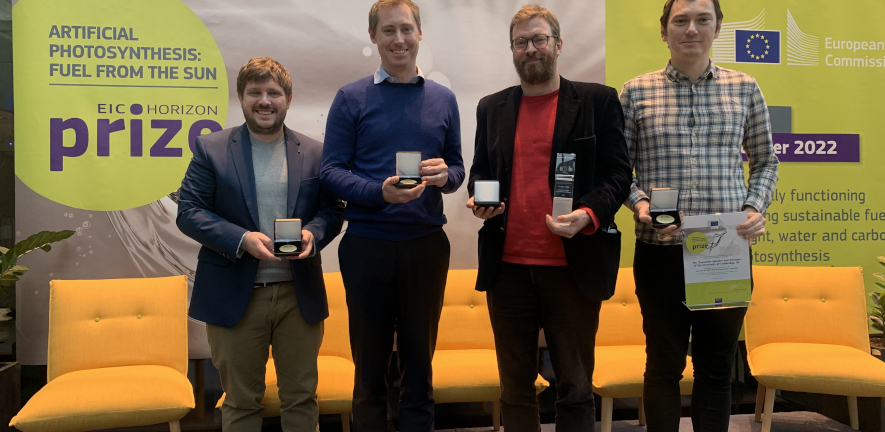
The team, made up of researchers from the Yusuf Hamied Department of Chemistry and the Department of Chemical Engineering and Biotechnology, was one of only three teams out of a total of 22 proposals who were selected for the finals of the competition, held earlier this summer in Ispra, Italy.
At the finals, the teams were required to demonstrate how their prototypes could convert sunlight, carbon dioxide and water into synthetic gas or syngas. Each team participated in a 72-hour test run of their systems, and on the final day they used the syngas they produced to drive a Stirling engine. The teams were assessed on their performance in the demonstration, combined with the overall concept of their design.
The artificial leaf array created by the Cambridge team was the culmination of three years of development. Their concept was to make a large array of artificial leaves using a combination of halide perovskite light absorbers – as a state-of-the-art alternative to silicon solar panels -- and photo-catalysts.
The ‘leaves’ use artificial photosynthesis to convert sunlight, carbon dioxide and water into synthetic gas or ‘syngas’ which can in turn be converted into liquid fuels such as hydrocarbons or alcohols.
The team had demonstrated the system previously on a small scale, but for the competition the challenge was to build a fully functional, bench-scale prototype of an artificial photosynthesis-based system which could produce a useable synthetic fuel. Their scaled-up demonstrator system showed potential for the production of syngas under real-world conditions.
The project combined previous research on artificial leaves from Professor Erwin Reisner’s group in this Department with a new approach to halide perovskite processing developed in Professor Sam Stranks’s group at the Department of Chemical Engineering and Biotechnology.
Erwin Reisner, who is Professor of Energy and Sustainability here said: “This is a very exciting step. Being able to produce syngas sustainably would be a critical step in closing the global cycle and establishing a sustainable chemical and fuel industry.”
Sam Stranks, who is Professor of Optoelectronics in the Department of Chemical Engineering and Biotechnology said: “This has been an extremely exciting yet challenging project ranging from fundamental materials science, chemistry and physics, to scaled-up engineering of the photo-abosorbers and catalysts.”
While great advances are being made in generating electricity from renewable energy sources, the development of synthetic petrol is also vital, as electricity can currently only satisfy about 25 percent of our total global energy demand. Artificial photosynthesis is widely considered to be among the most promising new technologies to deliver sustainable alternatives to current fuel supplies.
The research was supported by the Royce programme, the Maxwell Centre, the University of Cambridge School of Technology, the Yusuf Hamied Department of Chemistry and the Centre of Advanced Materials for Integrated Energy Systems (CAM-IES).
The finalists were announced at the ‘Artificial Photosynthesis: Fuel from the sun’ event, held at the European Commission on the 5th of December.
The winning entry for the €5 million prize was a team from the University of Tokyo in cooperation with INPEX Corporation (Japan).


Research
Virgil Andrei, Bertrand Reuillard and Erwin Reisner, Bias-free solar syngas production by integrating a molecular cobalt catalyst with perovskite-BiVO4 tandems, Nature Materials (2019).
Yu-Hsien Chiang, Miguel Anaya and Samuel D. Stranks, Multisource Vacuum Deposition of Methylammonium-Free Perovskite Solar Cells, ACS Energy Letters (2020).

